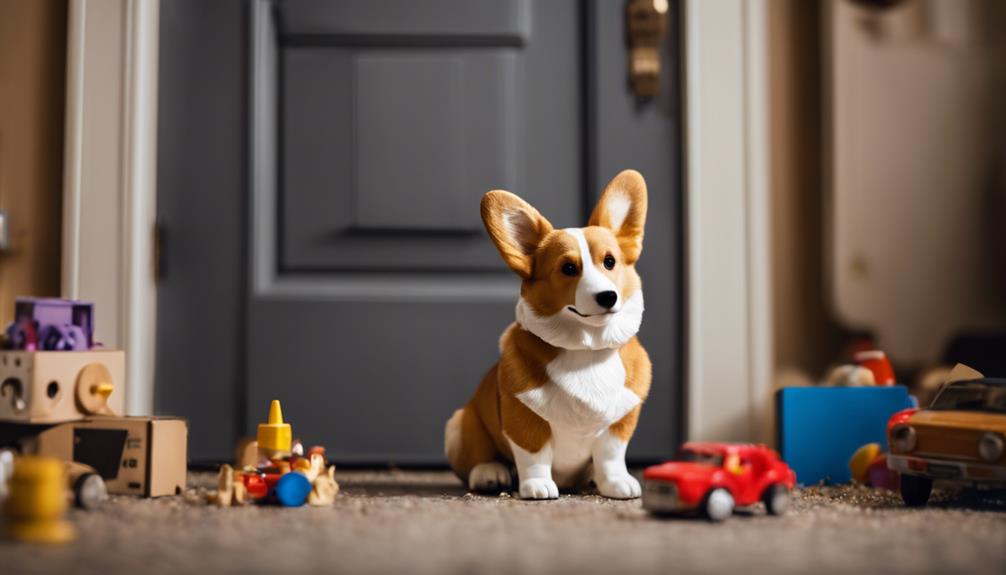Understanding the signs of Corgi separation anxiety is essential for any owner aiming to ensure their pet's well-being. Common behavioral indicators can manifest in various forms, such as vocalizations, destructive actions, and changes in daily habits. These behaviors not only reflect a dog's emotional state but can also lead to further complications if left unaddressed. By recognizing these signs early, owners can take proactive steps to alleviate their Corgi's distress. However, the nuances of these behaviors can be subtle and complex, prompting a deeper exploration into effective management strategies.
Common Behavioral Indicators

Common behavioral indicators of Corgi separation anxiety include excessive barking, destructive chewing, and attempts to escape when left alone. These behaviors often stem from a lack of confidence or fear of abandonment.
To mitigate these issues, implementing socialization techniques is crucial. Exposing your Corgi to various environments and people can help them feel more secure when alone.
Additionally, crate training serves as an effective method for providing your pet with a safe space. A properly introduced crate can become a comforting retreat, reducing anxiety during your absence.
It is essential to ensure that the crate is associated with positive experiences, such as treats and toys, to foster a sense of security.
These strategies can significantly alleviate behavioral problems linked to separation anxiety.
Physical Symptoms to Observe
When a Corgi experiences separation anxiety, certain physical symptoms can become apparent.
You may notice excessive barking and whining, which can signal their distress when left alone.
Additionally, destructive behaviors, such as chewing furniture or digging, often occur as they try to cope with their feelings of loneliness and fear.
Excessive Barking and Whining
Excessive barking and whining are often key indicators of Corgi separation anxiety, signaling the dog's distress in response to being left alone. These vocalizations can stem from various barking triggers and reveal specific whining patterns that indicate emotional turmoil.
It is crucial for Corgi owners to observe these behaviors closely. Here are some signs to watch for:
- Persistent barking, especially when the owner is preparing to leave
- Whining that escalates in intensity over time
- Barking or whining during times of solitude
- Vocalizations that occur in response to certain environmental noises
Recognizing these signs can help owners address their Corgi's anxiety effectively.
Destructive Behaviors When Alone
Destructive behaviors, such as chewing furniture or digging at carpets, often manifest in Corgis suffering from separation anxiety, serving as physical symptoms of their distress during periods of solitude.
These actions indicate a need for cognitive enrichment, as bored or anxious Corgis may resort to destructive habits to cope. Providing engaging toys and interactive games can help alleviate this anxiety, redirecting their energy towards positive outlets.
Additionally, crate training can serve as a useful tool in managing separation anxiety. When introduced gradually, a crate can become a safe space for your Corgi, reducing feelings of vulnerability when left alone.
Vocalizations and Their Meanings

Corgis with separation anxiety often express their distress through a variety of vocalizations, each carrying distinct meanings that can help owners understand their emotional state. Recognizing these vocalization types is essential for identifying their needs and feelings.
Here are some common vocalizations and their corresponding emotional expressions:
- Barking: Indicates frustration or a desire for attention.
- Whining: Expresses anxiety or a plea for reassurance.
- Howling: Signifies loneliness or an attempt to communicate distress.
- Yipping: Reflects excitement or fear, often during sudden changes.
Understanding these vocalizations can greatly assist in addressing your Corgi's separation anxiety and improving their overall well-being.
Changes in Eating Habits
Alterations in eating habits can serve as significant indicators of a Corgi's emotional state, particularly when they are experiencing separation anxiety.
Changes in eating patterns may manifest as decreased appetite or reluctance to eat favorite foods. Some Corgis may even refuse meals entirely, while others might suddenly develop a voracious hunger, consuming food rapidly.
These shifts can indicate distress and may be linked to the dog's emotional well-being. For instance, a previously picky eater may start to prefer certain treats over regular kibble, highlighting a change in food preferences driven by anxiety.
Recognizing these signs is crucial for owners to provide appropriate support, ensuring their Corgis feel secure and comfortable in their environment.
Destructive Behaviors Explained

Corgis experiencing separation anxiety often exhibit destructive behaviors that can be concerning for their owners.
Common actions include chewing on household items, excessive barking, and attempts to dig or escape from their environment.
Understanding these behaviors is crucial for addressing the underlying anxiety and ensuring the well-being of your corgi.
Chewing Household Items
Destructive chewing of household items often signals underlying anxiety in dogs, particularly when they are left alone for extended periods. Corgis may chew as a way to cope with their feelings.
To address this behavior, consider the following strategies:
- Implement positive reinforcement: Reward your Corgi for chewing appropriate items.
- Use crate training: Create a safe space where your dog feels secure.
- Provide chew toys: Offer alternatives that satisfy their urge to chew.
- Increase exercise: Regular physical activity can reduce anxiety levels.
Excessive Barking Patterns
Excessive barking often reflects a dog's anxiety and distress, particularly when they are experiencing separation from their owner. This behavior can be triggered by various factors, known as barking triggers, which may include unfamiliar sounds, other animals, or changes in the environment.
Corgis, due to their noise sensitivity, may bark excessively in response to these stimuli, signaling their discomfort and need for reassurance.
Common excessive barking patterns include:
- Barking when left alone
- Reacting to noises outside
Understanding these patterns is crucial for addressing separation anxiety effectively. By identifying the specific barking triggers, owners can implement strategies to help their Corgis feel more secure, ultimately reducing their anxiety and excessive barking.
Digging and Escaping
Digging and escaping behaviors in dogs often signal underlying anxiety, particularly when they are left alone for extended periods. Corgis, known for their intelligence and energy, may resort to these destructive actions to cope with stress. These behaviors can lead to dangerous situations, especially if a Corgi attempts an outdoor escape.
Key indicators of digging and escaping include:
- Persistent digging in the yard or Corgi enclosure
- Attempts to squeeze through fences or gates
- Increased vocalizations during these behaviors
- Signs of frustration or agitation before digging
Understanding and addressing these signs is crucial to ensuring the well-being of your Corgi and preventing potential injuries or escape attempts.
Strategies for Managing Anxiety
To effectively manage Corgi separation anxiety, it is essential to implement a combination of behavioral techniques, environmental modifications, and consistent routines.
Positive reinforcement plays a crucial role in this process. Reward your Corgi with treats or praise when they remain calm during your departures. Additionally, employing calming techniques, such as using anxiety wraps or soothing music, can help alleviate stress.
Establishing a consistent routine is vital; try to leave and return home at the same times daily. Create a safe, comfortable space for your Corgi, filled with their favorite toys.
Gradually increase the time you spend away from them, allowing them to adjust. By combining these strategies, you can help your Corgi feel more secure and reduce anxiety effectively.

